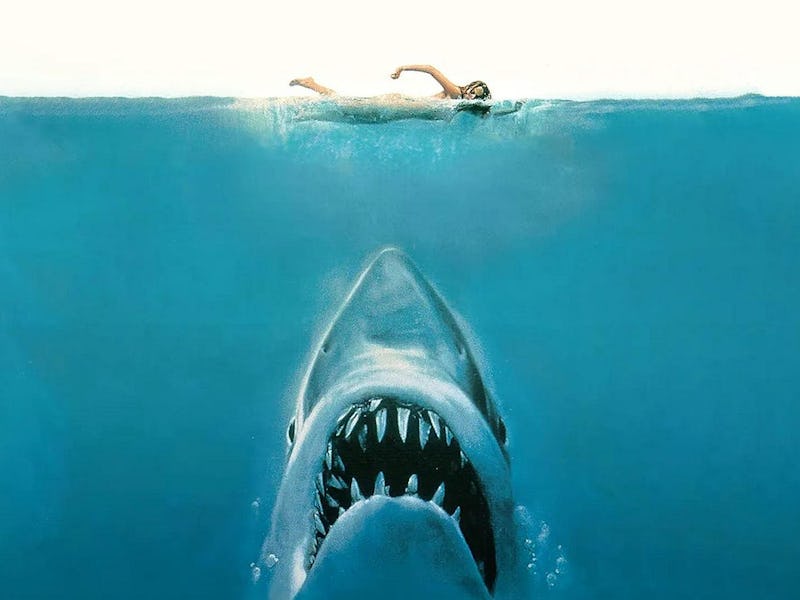50 Years On, Jaws Is Still The Ultimate Summer Horror Movie
Watch the water.

The horrors begin at sunrise, as a young woman frolics along the beach before heading into the water. Her giggles turn to screams as an unseen force begins to jerk her around before finally pulling her under, but what’s even more unnerving is the silence that ensues. For all it hones in on the dangers lurking in the murky ocean depths, Jaws, released 50 years ago today, is terrifying in how it leverages its boundless sun and sand, the very setting that entices oblivious tourists right into the surf. Like a shark fin through the water, director Steven Spielberg sliced through our perception of summer as a time of frolic and idyll, tying the sun to blazing terror instead.
Through his lens, a carefree vacation season is transformed into one of high alert in the fictional New England town of Amity Island. Cinematographer Bill Butler taps into an atmosphere of relaxation and leisure with a predominant palette of summer colors — yellow shores and blue water — only to pierce it with startling streaks of red when a great white shark begins its attacks.
Rather than use water tanks, Spielberg’s insistence on an open water shoot made Jaws the first major motion picture to be shot on the ocean. That led to a fraught production, but ultimately rendered the film’s horrors all too real as it twisted recognizable summertime scenes into a nightmarish tableau. A fountain of blood bursts through gently rippling waves. Rows and rows of suntanned bodies are reframed as prey. A young boy propels himself on his yellow floatie, only for it to wash up deflated, ripped, and abandoned. Bathing suits and bright trunks are replaced by black mourning attire. Every scene of tourists wading into the water conjures fear. Is that scream one of delight or devastation? Is that a bobbing grey shape a swimming cap or a shark fin? Each time the camera dips below the surface, it prompts a jolting stomach-lurch of anticipation.
The sight of beachgoers running into the waves is eventually replaced by that of sailboats ferrying amateur shark hunters hoping to nab a bounty. John Williams’ cheery score announces the arrival of out-of-towners by the boatload on a sunny day; intercut with them thronging the island with their beach umbrellas and water coolers, however, are police chief Martin Brody (Roy Scheider) and oceanographer Matt Hooper’s (Richard Dreyfuss) frantic calls for reinforcements. As the tidal wave of tourists descends, an uncomfortable thought percolates: how many of them will make it back home?
At least some men got to bond while enjoying a little sun.
Summer isn’t just the setting against which Jaws’ horror unfolds; it’s also the reason it persists. When the shark first begins circling Amity, the Fourth of July holiday season is just days away. So reliant is the town’s economy on summer tourists that when Brody’s first instinct is to put up “Beach Closed” signs in the wake of a mangled corpse washing ashore, he discovers none even exist. Amity’s mayor repeatedly prioritizes profit over lives, insisting the beaches remain open despite subsequent attacks. “It’ll be one of the best summers we’ve ever had,” he says, obstinate in his denial. And despite having witnessed the carnage firsthand, even the locals initially bristle at the prospect of beach closure. They’re hellbent on enjoying the summer, even if it dooms them.
Even Jaws’ marketing played into its season-specific screams. The film’s release date was strategic, “deliberately delayed until people were in the water off the summer beach resorts,” according to producer David Brown. Meanwhile, fellow producer Richard Zanuck claimed, “Lifeguards were falling asleep at their stations, because nobody was going in the water; they were on the beach reading their book.”
Jaws drove audiences off the beach and into theaters, establishing the summer as a primetime release date for tentpole films and laying the groundwork for future blockbusters. One of its most memorable taglines was “See it before you go swimming!” Fifty years on, no seaside dip has ever been the same.